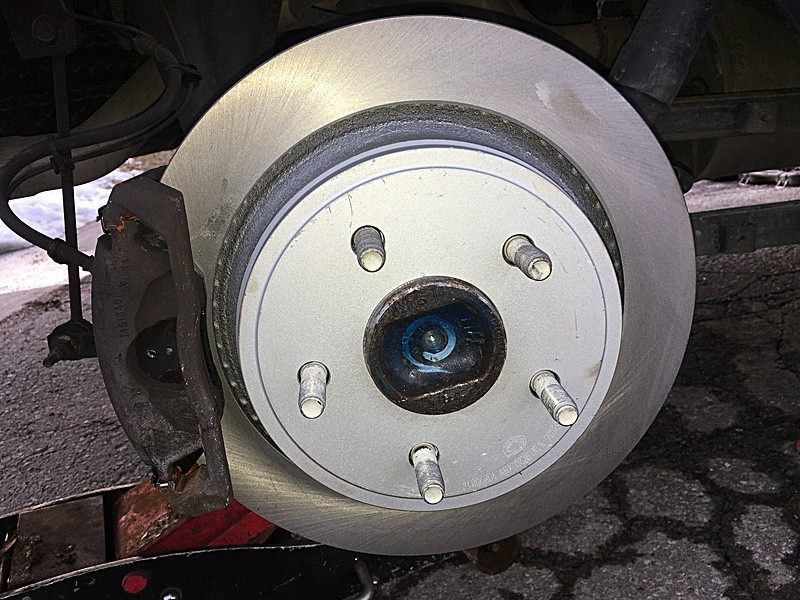Show Featured Articles
How to Replace Brake Pads and Rotors on Ram 1500
February 01, 2021 Do-It-Yourself steps for changing brake pads and rotors on your Dodge Ram 1500, 2009-2018 models.
Do-It-Yourself steps for changing brake pads and rotors on your Dodge Ram 1500, 2009-2018 models.
Parts & Materials Required
- Disc Rotors and Brake Pads kit
- Front brake kit (2 rotors with pads and hardware)
- Rear brake kit (2 rotors with pads and hardware)
- Front & Rear brake kit (4 rotors with pads and hardware)
- Grease for brake calipers
- Cleaner for brake pads
Tools Required
- Wheel chocks (to prevent your car from rolling)
- Jack and jack stands (to raise and support your vehicle)
- Socket sizes:
- 22mm or 7/8’’ (for 5 wheel lug nuts, 130 ft-lb preload torque)
- 13mm (to remove/reinstall caliper, 31 ft-lb preload torque)
- 21 mm (to remove/reinstall caliper bracket, 130 ft-lb preload torque)
- Breaker bar (for bolt installation)
- Ratchet with extension (for bolt installation)
- Caliper spreader tool or C-clamp (to wind-back the caliper pistons),
- Zip ties (optional - to temporarily support the disassembled caliper)
- Torque wrench (for proper preload of bolts and lug nuts)
- Hammer (to remove a seized rotor)
- Flat screwdriver (to pry out the caliper and pads)
- Pliers (to assist with bolt installation)
- Metal brush and rug (for cleaning the components of brake assembly)
Replacement Procedure
- Park the vehicle on solid and level surface. Use wheel chocks to prevent the vehicle from rolling.
- Loosen (but do not remove) the lug nuts using a breaker bar with 7/8’’ or 22mm socket.
- Jack up and support the the car, take off the lug nuts, and remove the tire.
- Use a wretched with 13mm socket to remove 2 hex bolts holding the caliper to the caliper bracket. Use pliers to hold the caliper slider from spinning.
- Place a flat screwdriver between the pad and the rotor, and carefully pry back to compress the piston and loosen the caliper.
- Slide the caliper out and hang it on the coil spring using a zip tie.
- Slide/pry out the old pads using a flathead screwdriver.
- Use the breaker bar with a 22mm socket to remove 2 hex bolts holding the caliper bracket. Slide the bracket off the rotor.
- Factory rotors would come with a washer retainer. Use pliers or side cutters to remove the retainer from the stud. Retainer is not structural and does not have to be reinstalled.
- If the rotor is frozen, use the hummer/sledge to hit the rotor hat between the studs to loosen it up. Be careful not to hit and damage the threaded studs.
- Use the wire brush to clean the pad clips channels on the caliper bracket.
- Take out the slider pins. Use brake pads cleaner to remove old grease/debris from the pins and the bores. Wipe the parts clean and apply new brake caliper grease.
- Slide the pins back into the bores. Make sure that protective rubber grommets are not damaged and properly snap over the pins.
- Install the new pads clips (hardware) on new pads. You may clean and reuse the old pads clips if they are not included with your replacement pads kit.
- Clean the wheel hub using the wire brush. Clean the friction surfaces of new rotors using the brake pads cleaner.
- Install the new rotor on the hub, then reinstall the caliper bracket. Preload both 21mm hex bolts to 130 ft-lb (or 175 Nm) using a torque wrench.
- Use the caliper spreader tool to push back the caliper piston. You may use a simple C-clamp, but be careful not to damage the protective rubber boot.
- Apply the brake caliper grease on pads clips (hardware), then install the pads. Be careful not to get the grease on the rotor/pad friction surfaces.
- Reinstall the caliper. Preload both 13mm hex bolts to 31 ft-lb (or 42 Nm) using a torque wrench. Use pliers to keep the caliper slide from spinning.
- Reinstall the wheel and tighten the lug nuts.
- Lower the car and preload the lug nuts in a cross-pattern to 130 ft-lb (or 175 Nm) using a torque wrench.
Disclaimer: Do-It-Yourself brake replacement requires some mechanical skills and knowhow, and the process entails certain risks. AllRotors is not responsible for any damages, liability, or injury that may directly or indirectly result from the posted information. It is the sole responsibility of the reader to understand and assume all risks associated with brake kit installation.


